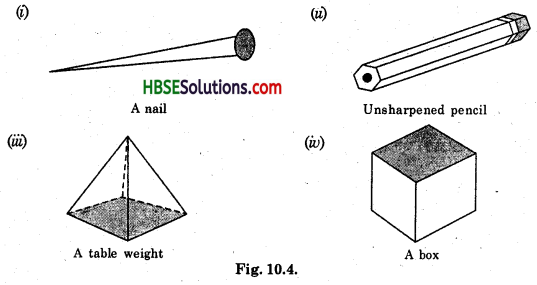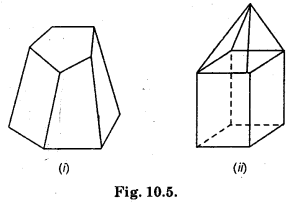Haryana State Board HBSE 8th Class Maths Solutions Chapter 10 Visualizing Solid Shapes Ex 10.3 Textbook Exercise Questions and Answers.
Haryana Board 8th Class Maths Solutions Chapter 10 Visualizing Solid Shapes Exercise 10.3
Question 1.
Can a polyhedron have for its faces
(i) 3 triangles ?
(ii) 4 triangles ?
(iii) a square and four triangles ?
Answer:
Since, each of solids (3-D) is made up of polygonal regions which are called its faces; these faces meet at edges which are line segments; and the edges meet at vertices which are points. Such solids are called polyhedron. Hence prisms and pyramids are polyhedron, but triangle and square are 2-D figures. So (i), (ii) and (iii) cannot polyhedron.
Question 2.
Is it possible to have a polyhedron with any given number of faces ?
[Hint: Think of a pyramid]
Answer:
A pyramid is a solid whose base is a plane rectilinear figure whose side faces are triangles having a common vertex, called the vertex of the pyramid.
A pyramid is a polyhedron whose base is a polygon (of any number of sides) and whose lateral faces are triangles with a common vertex. If we join all the corners of a polygon to a point not in its plane, we get a model for pyramid.
![]()
Question 3.
Which are prisms among the following :

Answer:
A solid whose two faces are parallel plane polygons and the side faces are rectangles is called a prism.
Hence (iii) A table weight is prism.
Question 4.
(i) How are prisms and cylinders alike ?
(ii) How are pyramids and cones alike ?
Answer:
(i) A triangular prism is made up of two parallel end faces each one of which is a triangle and three lateral faces each one of which is a rectangle. A right circular cylinder has two plane ends. Each plane end is circular in shape. These two circular regions are congruent and parallel to each other. Hence, prisms and cylinders are alike.
(ii) A pyramid is a polyhedron whose base is a polygon and whose lateral faces are triangles with a common vertex. A triangular pyramid has a triangle as,it base. A right circular cone has a plane end which is circular in shape. This end is called the base of the cone. Hence pyramids and cone are alike.
![]()
Question 5.
Is a square prism same as a cube ? Explain.
Answer:
A square prism is made up of two parallel end-faces each one of which is a triangle and three lateral faces each one of which is a square. In a cube, its faces are congruent, regular polygons. Vertices are formed by the same number of faces. Thus a square prism and cube has a square of it base. Clearly their bases are square. Hence square prism and cube are same.
Question 6.
Verify Euler’s formula for these solids.

Solution:
Since, F + V = E or F + V- E = 2
This relationship is called Euler’s formula.
Where, F = Number of faces
V = Number of vertices
E = Number of edges.
(i) F = 7, V = 10, E = 15
From Euler’s formula,
F + V – E = 2 .
L.H.S. = 7 + 10 – 15
= 17 – 15 = 2, R.H.S.
Hence, verified the Euler’s formula.
(ii) F = 5, V = 5, E = 8
∴ F + V – E = 2
L.H.S. = 5 + 5 – 8
= 10 – 8 = 2 R.H.S.
Hence verified the Euler’s formula.
![]()
Question 7.
Using Euler’s formula find the unknown.

Solution:
∵ F + V – E = 2
(i) F = 2 + E – V
= 2 + 12 – 6 = 14 – 6 = 8
(ii) V = 2 + E – F
= 2 + 9 – 5 = 11 – 5 = 6
(iii) E = F + V – 2
= 20 + 12 – 2
= 32 – 2 = 30
Question 8.
Can a polyhedron have 10 faces, 20 edges and 15 vertices ?
Solution:
For any polyhedron,
F + V – E = 2
Hence, L.H.S. = 10 + 15 – 20
= 25 – 20 = 5
Hence L.H.S. ≠ R.H.S.
This is not verified from Euler’s formula.